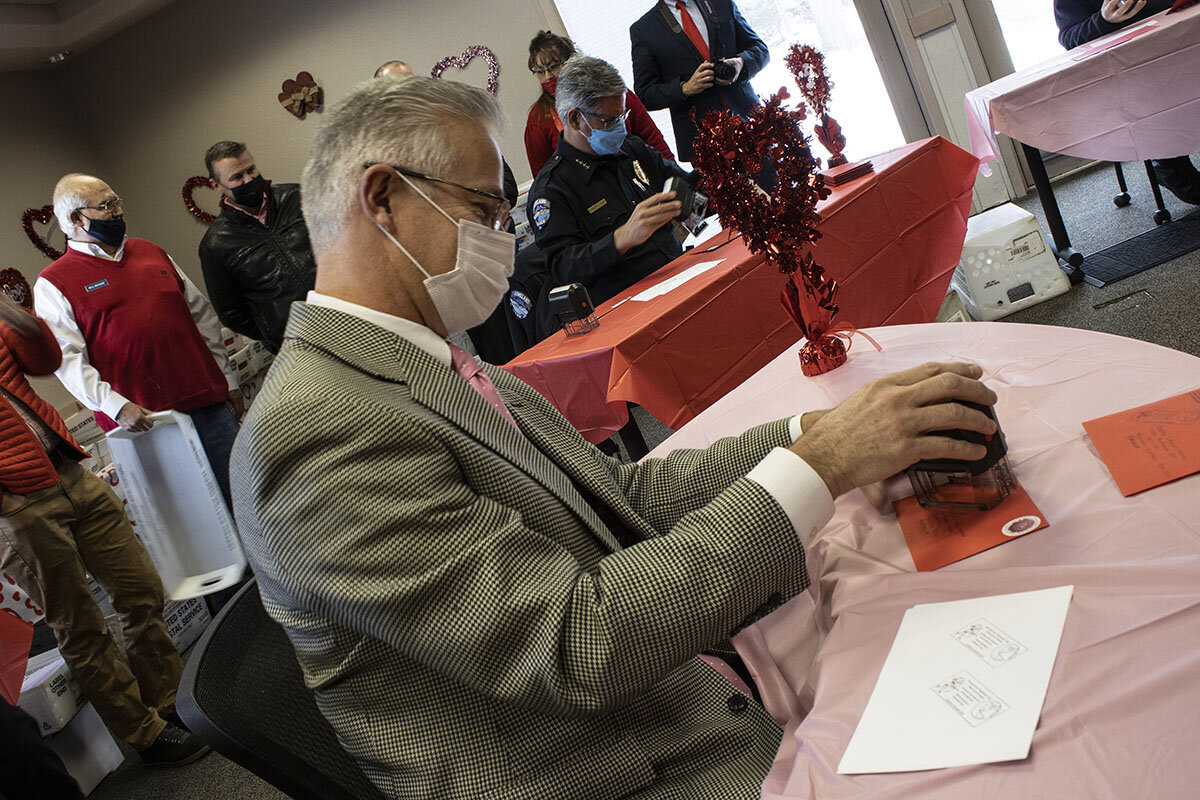From Colorado with love: One town’s heartfelt mission
Loading...
| Loveland, Colo.
Love is in the airmail. Just ask Joyce Boston, who has volunteered to stamp valentines en route to special someones for a quarter century.
“I have been a widow for 13 years, and I just think it keeps me wanting to keep going,” says the senior, stamp at the ready. “Spreading love ... in this country right now, we really need that.”
She resumed her duties Jan. 31 to kick off the Loveland, Colorado, 76th annual Loveland Valentine Re-mailing Program. The tradition of routing love notes through the so-called Sweetheart City, where they get a special postmark and verse, celebrates small acts of kindness.
Why We Wrote This
In an age of email, texts, and tweets, a snail mail valentine can be quite a treat. For years now, volunteers in Colorado have been making those missives even sweeter – and spreading joy around the world.
“It’s very important, especially in today’s society, that we continue to showcase love and spread joy and happiness around the world,” says Mindy McCloughan, president and CEO of the Loveland Chamber of Commerce, which hosts the event.
Around 200 helpers were expected this year over multiple shifts across a couple of weeks. At the kickoff, volunteers in heart headbands sat at spaced-apart tables, each stamp sounding like a mechanical kiss. Meanwhile, a red-sweatered barbershop quartet crooned.
“Heart of my heart, I looove youuu,” they harmonized.
Loveland, founded in the late 1800s along the Colorado Central Railroad, leans into its name with other love-themed festivities. A two-day Sweetheart Festival in February delights downtown. Light poles are decked with wooden hearts bearing declarations of love. A local theater manager, who was also the chamber of commerce president, was involved in the launch of the re-mailing program in the 1940s in collaboration with the postmaster.
The courier of cupid’s arrows – the United States Postal Service – still partners with the chamber on the program. Last year over 100,000 cards came through, says Jacqueline Leivestad, acting station manager of Valentine Station.
By designated dates in early February, letter-senders can mail a pre-stamped, pre-addressed card enclosed within a larger first-class envelope to Loveland. Volunteers stamp each card twice: with a postmark from Valentine Station and a valentine-themed verse, called a cachet, next to it. Volunteers have garnished greetings that are sent nationwide and to more than 100 countries. One of the first cards to be stamped this year, it’s announced, is bound for France.
“Bonjour, y’all!” Ms. McCloughan exclaims.
Loveland isn’t the only place where lovebirds can re-mail their missives. Post offices from Bliss, Idaho, to Valentine, Texas, have offered similar services, according to the USPS, though the Loveland organizers claim their initiative is the largest of its kind. It even involves a local Miss Loveland Valentine; this year it’s high school senior Olivia Friske, who was at the kickoff in a dress and sash. “I’m going to send [a valentine] to my grandparents,” she says. “They always send me one every year, so this year I get to send them one.” Her boyfriend will get one, too.
The holiday holds a sweet significance to some volunteers. Ms. Boston, the veteran stamper, says instead of Christmas cards, she sends Valentine’s Day cards. She’s held onto the first one her husband gave her in 1952.
Though it’s a bit tattered with age, she says, “I still treasure that valentine.”







